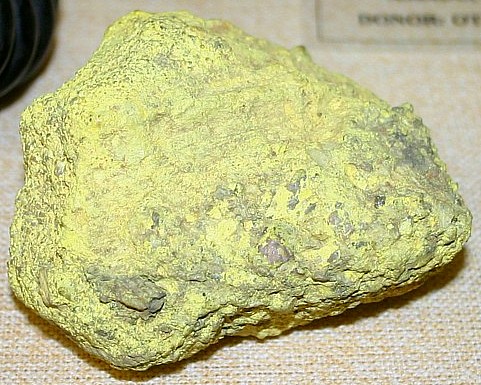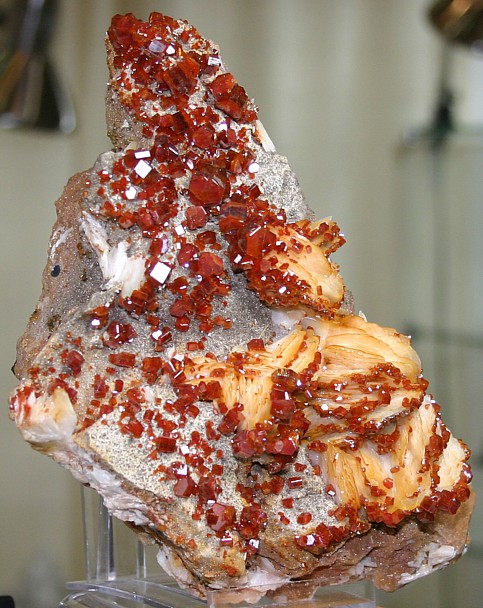Vanadium is a hard, ductile, silver-gray metal that is acid-forming (most metals form bases). It is known in more than 60 minerals, a number of which are very rare. Vanadium is commonly present in many igneous rocks in low concentrations. Vanadium minerals occur in the secondary alteration products of many veins of copper ore, lead, and other metals, but its primary source in these deposits is not well known. It forms rather soluble salts and migrates readily in cold solutions. The chief ore minerals of vanadium are patronite, carnotite, roscoelite, vanadinite, and mottramite. Less important are endlichite, a variety of vanadinite in which vanadium is partly replaced by arsenic, and descloizite. The most important of these vanadium minerals in the United States are carnotite, vandinite and roscoelite. These three are the only ones which occur in sufficient quantities in the United States to be available for ores. Roscoelite is a green micaceous mineral containing about 2 per cent of metallic vanadium. It is found in a soft sandstone near Placerville, Col. Carnotite is a sulphur yellow pulverulent mineral containing also uranium and potassium which is found in sandstones in several districts in Colorado and Utah, near the boundary line between the two states. Vanadinite is a secondary lead mineral which is found sparingly in the oxidized zones of certain lead deposits in Arizona and New Mexico. All of these ores are low grade, and are worked only in a small way and at intervals.
For many years, the chief supply of vanadium ores came from Peru, where there are large deposits of an impure carbonaceous sulfide of vanadium, known as patronite. Patronite is named after Antenor Rizo Patron, who discovered the deposits in which it occurs. Patronite occurs as a black amorphous material rich in vanadium sulfide. The material is carbonaceous and complex in character. The real composition of the vanadium compound present is doubtful, but it is supposed to be a sulfide having a composition which corresponds to the formula VS4. The ore has a specific gravity about 2.7.
The principal use of vanadium is for making specialized steel alloys, to which it gives great tensile and elastic strength, increased hardness, toughness, and power to resist shock. Most vanadium is produced as an iron alloy known as ferrovanadium which is used as an additive to improve steel. The ferrovanadium is produced directly by reducing a mixture of vanadium oxide, iron oxides and iron in an electric furnace. It is used also in making certain copper alloys. Vanadium salts are used as mordants in dyeing, for drugs, and in many chemical preparations. Metavanadic acid, HV03, is used as a yellow pigment, known as vanadium bronze. Vanadium oxide serves as a mordant in dyeing. A century ago, the comparatively small amounts of vanadium formerly required for chemical uses were obtained from various deposits of vanadinite, notably those of Spain, and those of Wanlockhead in Dumfriesshire, Scotland.
Most vanadium is now produced as a byproduct of other mining and fuel burning operations. In China and Russia vanadium is produced from steel smelter slag; in other countries it is recovered from the flue dust of operations burning heavy oil. It is also recovered as a byproduct of uranium mining, and should increase with the production of uranium ore in the US. A new vanadium mine is being permitted at the Gibellini Vanadium project in Eureka County, Nevada where vanadium will be the only important product. Much of the world's current vanadium production originates from vanadium bearing magnetite formed in ultramafic gabbro bodies. Vanadium is mined mostly in South Africa, north-western China, and eastern Russia. In 2010, these three countries mined more than 98% of the world’s vanadium. Vanadium is found in very small quantities, in titaniferous magnetites, presumably in close association with the mineral rutile. Rutile is frequently vanadium bearing.
Historically important deposits of vanadium are found at Minasragra, near Quisque, Province of Pasco, in the Andes of Peru. These deposits are in Mesozoic sediments that are intruded by numerous dikes of eruptive rock. The principal vanadium deposit occupies a fault fissure, and the sulphide, patronite, is associated with coke and asphaltum. The patronite, occurs here on a large scale as greenish-black masses associated with a hydrocarbon and a peculiar nickel-bearing pyrite. The patronite occurs as a constituent of a bed of ore 300 feet in length and from 3 to 6 feet in thickness, intercalated among highly inclined red shales of Cretaceous age. These shales are traversed by dykes of quartz porphyry and diabase, and the carbonaceous matter is in places converted into coke. The ore-stuff is highly carbonaceous, and is associated with vanadiferous asphalt. It contains pyrites and free sulphur in addition to patronite. An analysis of the patronite gave 58.79 percent sulphur, 19.53 percent vanadium, 0.18 percent molybdenum, 1.87 percent nickel, and 3.47 per cent, carbon. The deposit is said to be a vein with much bitumen and clay in gently dipping Cretaceous strata. Igneous rocks are present in abundance.
Traces of vanadium are found in most igneous rocks, and some varieties of augites carry as much as 2 per cent, of the metal. Titanic iron ores usually contain a fraction of a percent. Smaller quantities occur as oxidation products in many ore deposits, mostly as vanadinite or descloizite. Vanadium tends to concentrate in clays and shales; it is also concentrated in coal; the ashes of many varieties are rich in vanadium. A coal from the copper deposits in sandstone of Red Gulch, Colorado, contained 0.18 per cent, vanadium. The processes of weathering and vegetation appear to be favorable to its concentration; and, to some extent, uranium shares in this behavior. It is noteworthy that the ash of asphalt and coal sometimes contain considerable amounts of vanadium. Certain Peruvian asphalts contain one per cent, of vanadic oxide, and the ash left after burning the asphalt contains from 25 to 40 per cent, of vanadic oxide. A specimen of Colorado coal from Rockvale was found to contain 10 percent of ash, and the ash contained 27 per cent, of vanadic oxide.
UNITED STATES. The Mesozoic sandstones of Colorado and Utah provide supplies of vanadium ore of considerable importance, which are mined together with Uranium in the form of carnotite. In Colorado, vanadium ore is mined in the San Miguel and Montrose counties. In San Miguel county, a bed of Jurassic sandstone 9 feet thick, and impregnated with roscoelite, is worked at Bear Creek near Newmire, and also at Placerville. Near Placerville, Colo., roscoelite, together with a little carnotite, cements grains of quartz sand of the La Plata. These deposits are worked for both vanadium and uranium. Also in this district is a vein which occupies a fault and carries vanadium and some uranium. A horizontal parting in the sandstone marks the presence of a thin vein of roscoelite and quartz less than an inch thick. The material of this vein carries as much as 8 per cent, of vanadium in places, but the sandstone as a whole does not average more than two percent vanadium, and much of it does not carry more than one per cent. Here and there a little carnotite is associated with the roscoelite. At Paradox valley in Montrose County, sandstone impregnated with carnotite is mined; the sandstone outcrops in various places on the sloping sides of the valley and is readily worked. Carnotite-bearing sandstone is found also in Utah at various localities. On the east side of San Rafael Swell, ore containing 3.87 per cent, of vanadic oxide and 2.24 per cent, of uranium oxide has been produced in quantity.
Vanadinite associated with wulfenite and endlichite occurs at various localities among the Sierra de los Caballos in New Mexico, in galena veins of silver ore, which yield rock containing from 40 to 60 percent lead and 7 or 8 percent vanadium. It also occurs in Arizona, where ore averaging about one percent vanadic oxide is found in copper ores in the Shattuck mine, Bisbee, Arizona. Vanadium minerals also occur in the Yellow Pine district, in Nevada.
OTHER LOCALITIES. Vanadium ore has also been mined at Olary, South Australia. Of other occurrences of vanadium ore those of mottramite are worthy of note. Mottramite is a hydrated vanadate of lead and copper, the exact composition and formula of which is variable. It is found in the form of black or brownish encrustations. It occurs as an impregnation of Keuper sandstone at Mottram St. Andrews and Alderley Edge in Cheshire, where it was formerly worked to a small extent as a source of vanadium compounds. Mottramite has also been mined as a vanadium ore in the Otavi district of South-West Africa, where it is found in substantial deposits associated with copper ore. Vanadinite has been mined in Santa Marta in Estremadura, Spain. Descloizite has been mined in Argentina, South America; and it has been obtained as a by-product in working the zinc ore of Broken Hill in Zimbabwe.
Return
to Metal Ores Page:
Precious and Base Metal Ores

This is Carnotite, an important ore of Uranium, but which also produces byproduct Vanadium. It is mined in several places in the US.

This is Vanadinite, an ore mineral which is mined for the industrial metal vanadium. It is a complex lead vanadate.
